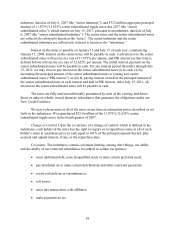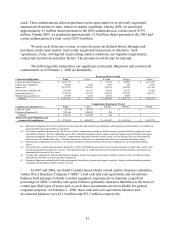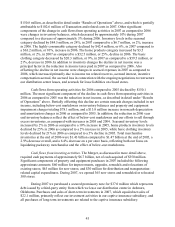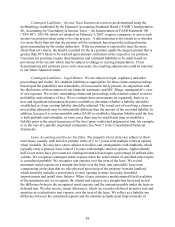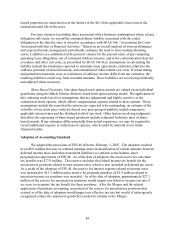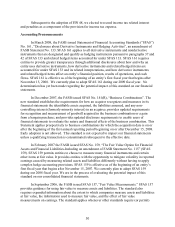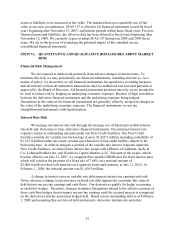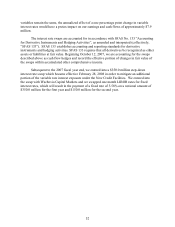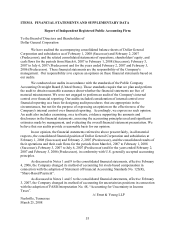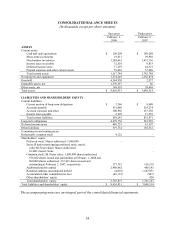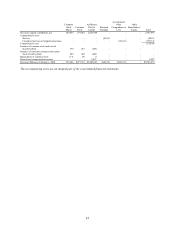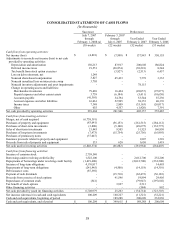Dollar General 2007 Annual Report Download - page 50
Download and view the complete annual report
Please find page 50 of the 2007 Dollar General annual report below. You can navigate through the pages in the report by either clicking on the pages listed below, or by using the keyword search tool below to find specific information within the annual report.48
Contingent Liabilities – Income Taxes Income tax reserves are determined using the
methodology established by the Financial Accounting Standards Board (“FASB”) Interpretation
48, Accounting for Uncertainty in Income Taxes – An Interpretation of FASB Statement 109
(“FIN 48”). FIN 48, which we adopted on February 3, 2007, requires companies to assess each
income tax position taken using a two step process. A determination is first made as to whether
it is more likely than not that the position will be sustained, based upon the technical merits,
upon examination by the taxing authorities. If the tax position is expected to meet the more
likely than not criteria, the benefit recorded for the tax position equals the largest amount that is
greater than 50% likely to be realized upon ultimate settlement of the respective tax position.
Uncertain tax positions require determinations and estimated liabilities to be made based on
provisions of the tax law which may be subject to change or varying interpretation. If our
determinations and estimates prove to be inaccurate, the resulting adjustments could be material
to our future financial results.
Contingent Liabilities - Legal Matters. We are subject to legal, regulatory and other
proceedings and claims. We establish liabilities as appropriate for these claims and proceedings
based upon the probability and estimability of losses and to fairly present, in conjunction with
the disclosures of these matters in our financial statements and SEC filings, management’ s view
of our exposure. We review outstanding claims and proceedings with external counsel to assess
probability and estimates of loss. We re-evaluate these assessments on a quarterly basis or as
new and significant information becomes available to determine whether a liability should be
established or if any existing liability should be adjusted. The actual cost of resolving a claim or
proceeding ultimately may be substantially different than the amount of the recorded liability. In
addition, because it is not permissible under GAAP to establish a litigation liability until the loss
is both probable and estimable, in some cases there may be insufficient time to establish a
liability prior to the actual incurrence of the loss (upon verdict and judgment at trial, for example,
or in the case of a quickly negotiated settlement). See Note 7 to the Consolidated Financial
Statements.
Lease Accounting and Excess Facilities. The majority of our stores are subject to short-
term leases (usually with initial or primary terms of 3 to 5 years) with multiple renewal options
when available. We also have stores subject to build-to-suit arrangements with landlords, which
typically carry a primary lease term of 10 years with multiple renewal options. Approximately
half of our stores have provisions for contingent rentals based upon a percentage of defined sales
volume. We recognize contingent rental expense when the achievement of specified sales targets
is considered probable. We recognize rent expense over the term of the lease. We record
minimum rental expense on a straight-line basis over the base, non-cancelable lease term
commencing on the date that we take physical possession of the property from the landlord,
which normally includes a period prior to store opening to make necessary leasehold
improvements and install store fixtures. When a lease contains a predetermined fixed escalation
of the minimum rent, we recognize the related rent expense on a straight-line basis and record
the difference between the recognized rental expense and the amounts payable under the lease as
deferred rent. We also receive tenant allowances, which we record as deferred incentive rent and
amortize as a reduction to rent expense over the term of the lease. We reflect as a liability any
difference between the calculated expense and the amounts actually paid. Improvements of


